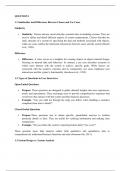Essay
ICT2622 ASSIGNMENT 2 ANSWERS 2024 SEMESTER 2 (PRESCRIBED BOOK & STUDY GUIDE USED) //wa.me/
- Course
- ECS4863
- Institution
- University Of South Africa (Unisa)
ICT2622 ASSIGNMENT 2 ANSWERS 2024 SEMESTER 2 (PRESCRIBED BOOK & STUDY GUIDE USED) //
[Show more]



